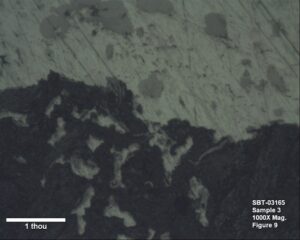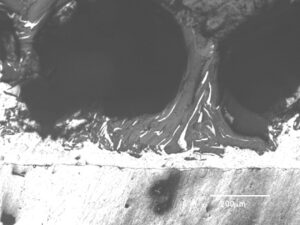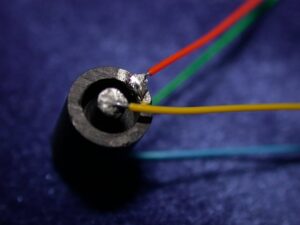S-Bond® active solders enable graphite bonding and the joining of other carbon or carbide based materials to each other and to most metals within the constraints of thermal expansion mismatch. S-Bond alloys have active elements such as titanium and cerium added to Sn-Ag, Sn-In-Ag, and Sn-Bi alloys to create a solder that can be reacted directly with the carbon surfaces prior to bonding using specialized S-Bond treatments prior to solder joining. Reliable joints have been made between graphite and carbon based materials with all metals including steel, stainless steels, titanium, nickel alloys, copper and aluminum alloys…
The joints produced:
- Are ductile, based on Sn-Ag or Sn-In alloys
- Exceeds the strength of carbon and graphite
- Are thermally conductive, with S-Bond alloys having k = 50 W/(m-K)
- Are metallic and this electrically conductive with a metallurgical bond
S-Bond alloys has been shown to wet and adhere to a wide variety of the graphite and carbon, including:
- All Grades of Graphite
- Metal infiltrated graphite
- Graphite and Carbon Foams
- Pyrolytic Graphite
- High conductivity graphite fibers
- Diamond
S-Bond graphite bonding and joining to carbon based materials is thermally activated using S-Bond Technologies proprietary process, which prepares the graphite-carbon surfaces and develops a chemical bond to the surface, through reactions of the active elements in S-Bond alloy. These joints start with processing the graphite/carbon surfaces at elevated temperatures in a protective atmosphere furnace with S-Bond alloy placed on the graphite-carbon surfaces to be joined. At these elevated temperatures, the active elements in S-Bond (Ti, Ce, etc.) react with the ceramic to develop a chemical bond, as shown in the Figure 1.
Figure 2 shows the actual interaction of the S-Bond layers to the underlying graphite in graphite bonding. The chemical bond forms TiC based and the S-Bond layer in a subsequent joining step provides a much higher level of joint strength and creates high performance joints. After pretreatment with S-Bond alloy, the re-heated graphite or carbon can be joined to aluminum face sheets or other types of metals and composites.


S-Bond graphite bonding processes have been developed that can adhere to graphite foam materials and to solid graphite. Examples of the interfaces are shown in Figure 3. The metallurgical bond and the mechanical bond work well for Gr-Foam as the structure in Figure 3 illustrates.

S-Bond alloys wet and encapsulate the Gr-foam webs, leading to adherence and gripping around the Gr-foam webs, thus creating strong and thermally conductive joints. S-Bond joining has been shown to be an effective and promising method for joining highly conductive graphite foams to metallic and composite face sheets. Joint strengths, tested in double lap shear, far exceeded the strength of the Gr-foams themselves [over 2 MPa] and after 100 thermal cycles, cycling from –50 to 150C, the joint strengths did not decrease.
Thermal properties (heat transfer coefficients in closed loop water) were measured and showed the S-Bond joined Gr-foam samples had superior heat transfer coefficients compared to commercial aluminum fin-plate heat exchangers, which have heat transfer coefficients between 10,000 and 20,000 W/m2K, compared to 500 – 1200 W/m2K for commercial aluminum fin-plate designs. These results have clearly demonstrated that S-Bond joining, in combination with Gr-foam have significantly enhanced the performance of Gr-cored thermal management devices, increasing their cooling power, lowering weight and decreasing their size. The design flexibility that S-Bond joined Gr-Foam materials allow may radically change future shapes, sizes and locations of thermal management systems.
Applications
Graphite and carbon based materials are normally used in thermal management or electrical connections or sensors and are used for their high electrical and thermal conductivity, and low friction properties. They find application in electrical sensors, power leads and feed throughs, and motor brushes. Metal conductor leads need to be attached and many times the attachment has been mechanical staking or epoxy. S-Bond joining creates a metallurgical bonded solder connection, creating much lower profile electrical connections, especially useful for small sensors and brushes.
Gr-Foams and graphite bonding offer revolutionary advancements in thermal management. Graphite foams, graphite fibers and pyrolytic graphite can all be joined using S-Bond processes. Examples of applications and components are shown below. S-Bond joints have been proven to be thermally conductive and enhance the performance of graphite based thermal management devices, especially those made from graphitic foams.
Figures 4 – 7 illustrate graphite cored heat spreader, large electrical carbon brush assemblies and small graphite electrodes for sensors along with the graphite/S-Bond interface on the tip of the electrode pin.




S-Bond Technologies has developed extensive experience in active, S-Bond solder joining graphite, carbon and carbide to metals. Contact us to evaluate our joining solutions for your graphite bonding and carbon joining applications.

5 Responses
Where am I able to purchase this product?
Regards,
Rand L Petersen, President
Rand International Inc.
Is this product viable for producing a laminate material between pyrolytic carbon and 1018 steel sheets?
Yes, within the constraints of CTE mismatch. please contact us direct at [email protected]
I’m not sure if your process or product is right for my needs but I would like to find out if you can help . I have a carbon fiber backplate that belongs with a carbon fiber spinner for the use of a 100cc gas airplane engine.
I need to bond two copper rings to the back of the backplate which will act as contacts for an electrical current while the spinner is rotating.
The copper rings are approx 1/8″ wide copper and the rings are about 2 1/2″ and. 3″ in dia
Can you help?
Yes S-Bond 220 and related joining methods can do this, within the constraints of CTE mismatch. please contact us direct at [email protected]